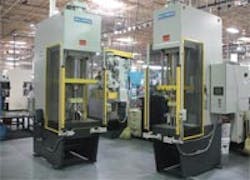A spate of new forging press designs and installations in the news over the past few months has impraessed the point that ought to have been understood all along: if you’ve got a metal part to form, there’s a press design that will do it for you. Even in the slow-moving world of automotive and commercial-vehicle manufacturing, the demand for precision and high-throughput put pressure on press designers for equipment that meets the highest standards for product quality, availability, reliability, and cost effectiveness.
Hydraulic presses for ball-joint assemblies
Two new hydraulic presses were installed last summer at the ZF Commercial Suspension Systems & Components in Lancaster, SC, by Multipress Inc. The plant is an operating unit of ZF Friedrichshafen AG, a global manufacturer and supplier of drivetrain and chassis components for automotive, commercial vehicle, off-highway, marine, rail, and aerospace industries.
Since 2008, ZF Commercial Suspension Systems & Components has been producing inline ball-joint assemblies in South Carolina. The two hydraulic presses are critical to the manufacturing processes.
According to Multipress, ZF’s engineers determined that high-quality production of these safety-critical components could be relocated to North America if the process incorporated advanced production standards — including ram-position control specifications as precise as ± 0.0015 in. Multipress custom configured two floor-mounted C-frame hydraulic presses to fill the order, one rated at 100 tons and another at 50 tons.
Each press incudes a series of electronic and mechanical sub-systems that ensure the specified accuracy on a consistent basis. A Delta motion controller working together with an Allen-Bradley PLC divides the speed of the downward ram stroke into three stages, with the maximum deceleration occurring within 0.10 in. of contact with the part. Dwell time and ram reversal are determined by the combined action of an electronic timer and a pressure transducer that ensure that both time and pressure on the work piece are within pre-programmed limits.
The hydraulic cylinder controls have a built-in linear transducer to control the contact position of the ram within the specified ± 0.0015 in. tolerance.
Multipress also supplied the press’s touch-screen HMIs, with models and menus that store various production plans for different ball joint sizes and shapes. The presses are fitted with light curtains and hard guarding for operator safety.
Screw press for front-axle beams
A more recent, and much larger screw press has been started up in Germany by Schneweiss & Co. GmbH, in Hagen. Schneweiss is an operating unit of the Mahindra Group, and forges chassis, steering, and engine parts for commercial vehicle manufacturers.
According to the press builder, Mller Weingarten, it’s the largest screw press in Germany. It was integrated into an existing production line, replacing a forging hammer. It will manufacture front-axle beams for commercial vehicles, with part up to 330 lb (150 kilograms) and approximately 79 in. (2,000 mm) long.
Mller Weingarten designed and built the screw press with hydraulic ejectors in the bed and slide, and developed links to the plant’s existing components to create a fully automated production process. The other units include the preforming machinery, an induction-heating unit and material feeding system, a deburring press, and a part transport system.
A centralized forging-line production control system was developed, too. The Mller Weingarten design monitors all preform production, material feeding, and part transport.
“The forging tools were transferred seamlessly from hammer to screw press,” according to Schneweiss production manager Wolfgang Putsch.
It’s now possible to run the line as three-shift operation, and the forger expects the screw press to increase die service life, because pressure dwell times have been minimize. The new machine concept will make it possible to achieve cycle times of less than 50 seconds per part, which would result in a total daily output of 1,400 front-axle beams.
